Introduction
This is final installment of a 6-part series of articles on stocks for 2014. In the previous five installments – Part 1, Part 2, Part 3, Part 4 and Part 5, my focus was primarily on stocks of various categories that I believed were fairly valued even after the strong run that the market has had over the past several years. However, with this final installment, my focus has changed to evaluating the potential pitfalls and/or challenges of investing in cyclical stocks, or more precisely, companies.
Nevertheless, I will be highlighting two cyclical stocks, Caterpillar Inc. (CAT) and Deere & Company (DE), which I believe are attractively-valued cyclical stocks today. Candidly, there were many other cyclical stocks that I came across that also appeared reasonably valued. However, as I will be expressing throughout this article, I believe that cyclical stocks should be approached with both great caution, and a clear understanding of the nature of the beast.
Depending on what your overall investment philosophy and/or approach is, stocks with cyclical operating records present investors with unique challenges. This is especially true for the retired long-term, buy-and-hold oriented dividend growth investor. In other words, it can be relatively easy to buy-and-hold a company with a consistent long-term record of earnings growth and accompanying dividend increases.
This is simply because when the inevitable short-term stock price volatility occurs with a consistent grower, especially to the downside, the investor can focus on the company’s earnings strength and dividend increases that can provide them the confidence to stay the course. I think this is important, because I am a firm believer in investing for the long-term. This has little to do with trading stocks, and everything to do with positioning yourself as a shareholder owner of a great company.
In contrast, during those inevitable periods where the earnings of a company with cyclical characteristics are dropping in tandem with stock prices, it’s often emotionally difficult to hold on, even if it makes sense to do so. Consequently, this article will address some of the issues and challenges associated with long-term buy-and-hold investing in cyclical or semi-cyclical dividend growth stocks. In addition to discussing how to deal with long-term investing in cyclical stocks, I will also provide my personal perspectives on whether it’s a rational idea or not.
As an aside, since I am a believer in long-term investing versus day trading or swing trading, it is my personal strategy of choice. However, I am not brash enough to suggest that trading strategies are wrong; instead, I’m simply suggesting that long-term buy-and-hold investing suits me and my temperament better. Therefore, this article is likely to make more sense to other like-minded long-term buy-and-hold investors. Moreover, there is a fundamental mindset that differentiates the prudent investor from the speculator/trader.
My associate, Eli Inkrot, a young investor who I believe is wise beyond his years, has a way of expressing this differentiation of mindset in a manner that I really admire. Instead of referring to it as a buy-and-hold strategy, Eli calls it “partnering with a wonderful business.” To my way of thinking, that simple phrase both elegantly and profoundly says it all. The owners of “wonderful businesses” are in it for the long haul. The notion of selling their wonderful business, especially on a whim or as a knee-jerk reaction to what might be happening in an often wacky world (stock market), is simply not part of their DNA.
The Commonly Held Definition of a 'Cyclical Stock'
Moreover, in order for this article to make sense, I believe it’s imperative that we start by defining, as precisely as possible, exactly what a cyclical stock is. I feel this is both essential and important because, like many terms and concepts glibly thrown about within the financial services industry, there is often a wide lack of precision regarding the true meaning of the term. In my humble opinion, the term “cyclical stock” is one of those quite often loosely utilized and/or imprecisely defined terms.
For example, Investopedia defines a cyclical stock as follows:
“An equity security whose price is affected by the ups and downs in the overall economy. Cyclical stocks typically relate to companies that sell discretionary items that consumers can afford to buy more of in a booming economy and will cut back on during a recession. Contrast cyclical stocks with counter-cyclical stocks, which tend to move in the opposite direction from the overall economy, and with consumer staples, which people continue to demand even during a downturn.”
Frankly, although I believe that this definition does provide some insight into the general characteristics of a cyclical stock, I contend, as I will explain in greater detail later, that it lacks true precision. Perhaps that is part of the reason why Investopedia then goes on to attempt to explain a cyclical stock more fully as follows:
“Cyclical stocks rise and fall with the business cycle. This seeming predictability in the movement of these stock's prices leads some investors to try to time the market by buying these stocks at the low point in the business cycle and selling them at the high point. Examples of companies whose stocks are cyclical include car manufacturers, airlines, furniture retailers, clothing stores, hotels and restaurants. When the economy is doing well, people can afford to buy new cars, upgrade their home furnishings, go shopping and travel. When the economy is doing poorly, these discretionary expenses are some of the first things consumers will cut. If a recession is bad enough, cyclical stocks can become completely worthless as companies go out of business.”
The above expanded discussion of cyclical stocks does attempt to provide a deeper insight into the nature of a cyclical stock. However, although I agree with much of how the above commentary denotes the general characteristics of a cyclical stock, like many other financial terms, I believe it offers too general of an explanation. Moreover, I think the above discussion referring to some investors trying to time the market, is also overly-simplistic.
I especially have a problem with the phrase “seeming predictability in the movement of the stock’s prices.” First of all, I don’t think there is predictability in the stock price movements of any company, and secondly, cyclicality to my way of thinking is more about short periods of time when earnings are dropping. In other words, the so-called business cycles are periods of time when business temporarily becomes weak, and stock price follows these weak business results. Stated more precisely, cyclicality is more about profits, than prices.
With the above discussion in mind, I would now like to offer my own personal definition of what a cyclical stock is to me. Instead of thinking in broad terms such as restaurant stocks are cyclical, I prefer to base my judgments on the specific or individual company or business that I am examining. For example, if a company has a steady history of increasing its earnings each year, I would not think of it as a cyclical stock merely because it operates in a broad category that is considered cyclical. In other words, I will base my judgment about what kind of a stock a given company is, based on its specific operating history.
For example, according to the explanation of a cyclical stock explained by Investopedia as described above, restaurant stocks are cyclical. Therefore, if I come across a restaurant stock that I was interested in examining or researching, I might assume that I would see a company with an erratic or cyclical earnings history. However, in reality I might find a powerful growth story with little or no cyclicality with its earnings history. Consequently, the generalization that all restaurant stocks are cyclical would prove false. The operating earnings history of Panera Bread Company (PNRA) offers a quintessential example of my point.
(Note: these next three examples focus on earnings history in order to depict cyclicality, or the lack thereof, with no regard to stock price or current valuation)
Panera Bread Company (PNRA)
Panera Bread Company operates a retail bakery-cafe business and franchising business under the concept names such as Panera Bread, Saint Louis Bread Co., and Paradise Bakery & Café.
To my way of thinking, the following graph plotting Panera Bread’s earnings since 2001 depicts a powerful growth stock, not a cyclical stock. Therefore, even though it is clearly a restaurant stock in the general sense, in the specific sense I cannot think of it as a cyclical stock.
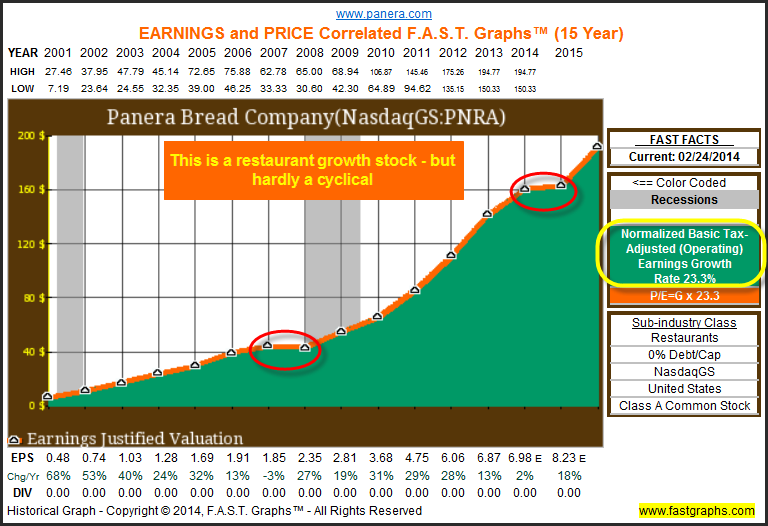
Biglari Holdings Inc. (BH)
Biglari Holdings Inc., through its subsidiaries, is engaged in the operation and franchising of restaurants in the United States. The company’s subsidiaries include Steak n Shake Operations, Inc. and Western Sizzlin Corporation.
In contrast, the following graph plotting the earnings of Biglari Holdings Inc. depicts a true version of what I would consider a cyclical stock to be. With this specific restaurant stock, we see wide swings and variations of earnings per share from one year or time period to the next. Therefore, in this case we see a specific example of a restaurant stock that is clearly also a very cyclical stock.
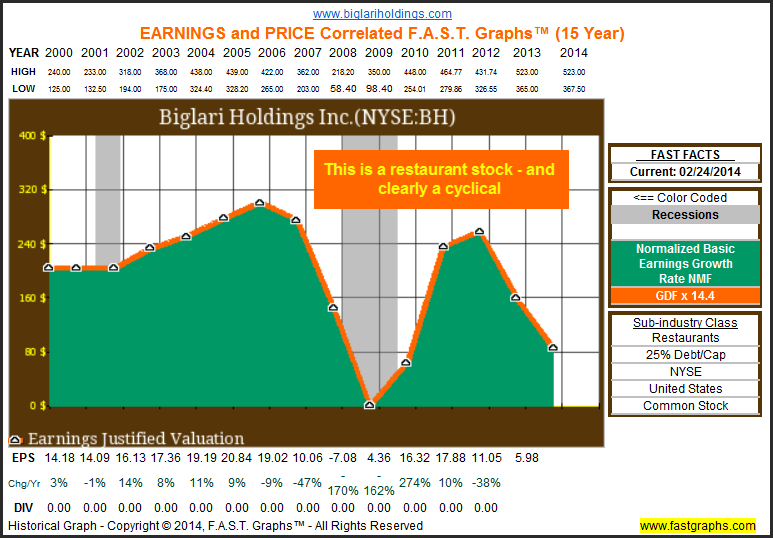
Starbucks Corporation (SBUX)
Starbucks Corporation engages in roasting, marketing, and retailing specialty coffee worldwide. The company operates in approximately 62 countries.
My third and final example of a restaurant stock, Starbucks Corporation, could be looked at as a hybrid comprised of a powerful growth stock with a moderate or occasional amount of cyclicality. In this case, earnings did falter slightly during the Great Recession of 2008, but only modestly and temporarily. Therefore, I would argue the case that Starbucks is better defined as a growth stock than as a cyclical stock. Or perhaps a semi-cylical growth stock, but hardly a true cyclical.
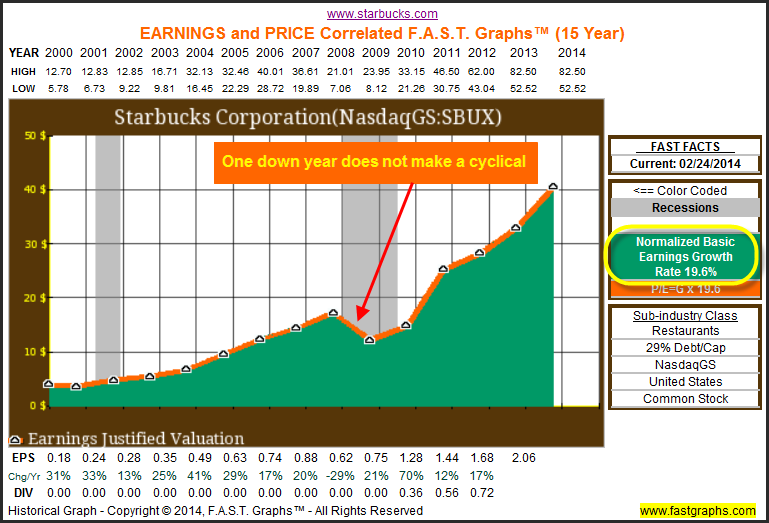
As an aside, this is one of the reasons I tend to question the validly of many of the so-called studies conducted, presented and utilized by Wall Street and academia. I’m not suggesting that the studies are wrong, or conducted improperly. However, I am suggesting that the underlying data that is being scrutinized is all too often using overly-generalized definitions of the various characteristics studied as they pertain to individual companies. Companies are as unique as people are.
For example, there are numerous studies comparing dividend paying stocks to non-dividend paying stocks. However, a closer examination of individual companies indicates there are wide differences in the true characteristics of the many individual companies being included. Consequently, I believe that putting all dividend paying stocks, or all non-dividend paying stocks into the same general pot could simply lead to erroneous conclusions being drawn.
Critical Thinking Or Thinking Logically
To provide an additional perspective of what I discussed in the above section, I believe one of the most important subjects I studied in college was logic. One of the primary premises behind this course is that it teaches "critical thinking." This is the mental process of ascertaining whether a statement or position is valid or invalid. More simply stated, this allows you to evaluate an argument through reasoning as to whether a premise leads to an accurate conclusion. If the original premise is false, it leads to a false conclusion even when the argument itself appears valid. Through logic I learned that arguments can be valid or invalid, but not true or false, and only that premises and conclusions are true or false.
Logic utilizes a tool referred to as a categorical syllogism, which reveals to the critical thinker whether an argument is valid or invalid, based on whether or not the original premise is true or false. Therefore, the argument that all restaurants are cyclical stocks presents a false premise. Consequently, drawing the conclusion that all restaurant stocks are cyclical stocks leads to a false conclusion.
Therefore, the primary point I was attempting to illustrate with the above examples is the validity of judging companies based on their own specific attributes, characteristics and merits, over thinking of them in more general terms such as a cyclical restaurant stock. Moreover, my own definition of a cyclical stock is one that has a history of erratically rising and falling earnings over time. But most importantly, I make my judgment of the cyclicality of a stock specifically based on reviewing each individual stock, one company at a time. Consequently, the premise that some restaurant stocks are cyclical is valid, while the premise that all restaurant stocks are cyclical is invalid.
Investing In Cyclical Or Semi-Cyclical "Wonderful Businesses"
There is an interesting perspective that can be articulated when analyzing the proper strategy for investing in cyclical stocks. I've seen many heated arguments between dividend growth investors focusing on dividend income, versus total return oriented investors. The dividend growth investor is most concerned with a rising dividend income stream. In contrast, the total return investor is more focused on maximum portfolio gain calculated by adding capital appreciation and dividend income together.
Frankly, I am somewhat amused by these arguments. To my way of thinking, neither side is right, nor are they wrong. They both have a legitimate position, which is uniquely supported based on their unique needs, goals or objectives. For example, the retired investor living off the income their portfolio provides is most concerned with yield and the growth thereof. Since they don't plan on selling their stocks anytime soon, price volatility is of little concern to them.
In contrast, the total return investor, perhaps in the accumulation phase, is most concerned with how fast their portfolio grows, and how big it gets. Consequently, price volatility is often a greater focal point than dividends. However, I would add that price volatility will likely also cause the total return investor more angst, which is more likely to initiate an emotional response. In other words, total return investors are less likely to remain calm in a tumultuous market environment.
With the above thoughts in mind, cyclical stocks pose additional challenges to both the dividend growth investor and the total return investor. To illustrate this point, I will utilize the blue-chip dividend growth company Caterpillar Inc - which is a Dividend Contender. To those not familiar with this list, these are companies that have increased their dividend for 10-24 consecutive years – David Fish provides this list and others on his CCC lists. Caterpillar Inc’s streak is currently 20 years.
Caterpillar Inc (CAT)
Caterpillar Inc manufactures construction and mining equipment, diesel and natural gas engines, industrial gas turbines and diesel-electric locomotives. The company was founded as Caterpillar Tractor Co. in 1925 in the State of California. In 1986, the company changed its name to Caterpillar Inc.
However, before I focus on dividends I will utilize the F.A.S.T. Graphs™ fundamental stock research tool and graph Caterpillar’s earnings since 1996 (the orange line on the graph). I have added arrows to indicate the cyclical nature of Caterpillar’s earnings-per-share over that time frame. I believe this represents a clear example of a company with a cyclical long-term operating history. Moreover, I might add that forecasting these exact cycles would be difficult, if not impossible to predict.

With my next 20-year graph on Caterpillar I will include the full complement of what a F.A.S.T. Graphs™ provides in order to illustrate one of the primary challenges that cyclical stocks present to investors. (Note: on a F.A.S.T. Graphs™ exceeding 15 years, only every other year’s data is typed on the graph’s headings, but all data is plotted). The black line on the graph plots monthly closing stock prices, and here we see that stock price follows and correlates highly to earnings (the orange line on the graph). The challenge to investors is that stock price will be weak, and performance poor during the weaker periods of Caterpillar’s business cycle.
On the other hand, we might also conclude that periods of weakness are typically temporary and followed by periods of strength. Consequently, this might also suggest that periods of cyclical operating weakness would be the best times to take a position in this cyclical Dividend Contender. Of course, this last point would be true whether your focus was on dividends or capital appreciation and/or total return. Buying low (in order to someday sell high) is one of the most basic of all investing tenets.
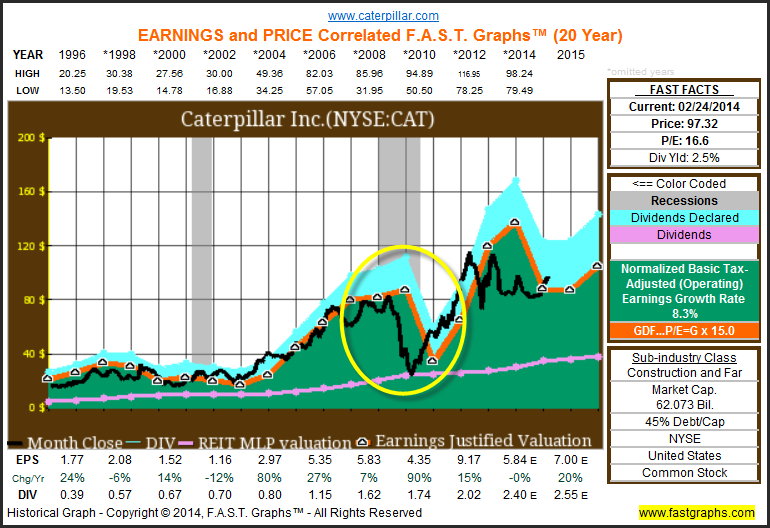
With my next graph, I’m going to shorten the time frame from 2005 to current. At the beginning of 2005, Caterpillar was trading at a fair value P/E ratio of approximately 15 (price was touching the orange line). However, that fair value P/E ratio of 15 was based on current earnings at that time. But most importantly, when earnings in 2009 fell to $2.29 from $4.21 in 2005, the fair value P/E ratio of 15 that was originally paid in 2005 meant that you were paying an overvalued P/E ratio of 22 for 2009’s ultimate forward earnings. This is where one of the biggest challenges of investing in a cyclical stock rears its ugly head. Everything was fine until we entered the Great Recession of 2008. In the spring of 2008 price turned down, apparently in recessionary anticipation of future earnings weakness, which did, in fact, soon occur.
Consequently, owning Caterpillar from 2005 to 2008 would have resulted in an annual loss averaging 2.2% per annum, from the perspective of capital appreciation. Naturally, this would not be acceptable to the total return oriented investor. Accordingly, and especially for the most impatient total return investor, this might more than likely instigate a sell decision somewhere along the way. On the other hand, these impatient investors would simultaneously be selling at what in truth would be one of the most opportune times to invest in the cyclical company Caterpillar Inc. Investing in cyclical stocks can be very challenging for the total return investor, or very profitable if their timing is correct.
In contrast, Caterpillar Inc.’s price and earnings volatility or cyclicality, might be less concerning to the dividend growth investor focused on a rising dividend income stream. The pinkish colored line on the graphs plots dividends per share, which in the case of Caterpillar Inc., steadily increased each and every year including the Great Recession years. However, that would only be true if the dividend growth investor was aware of the cyclical nature of Caterpillar Inc. in the first place. In other words, they would expect to see some cyclicality in earnings and price along the way. Moreover, they would only truly be concerned if their dividend income stream was interrupted.
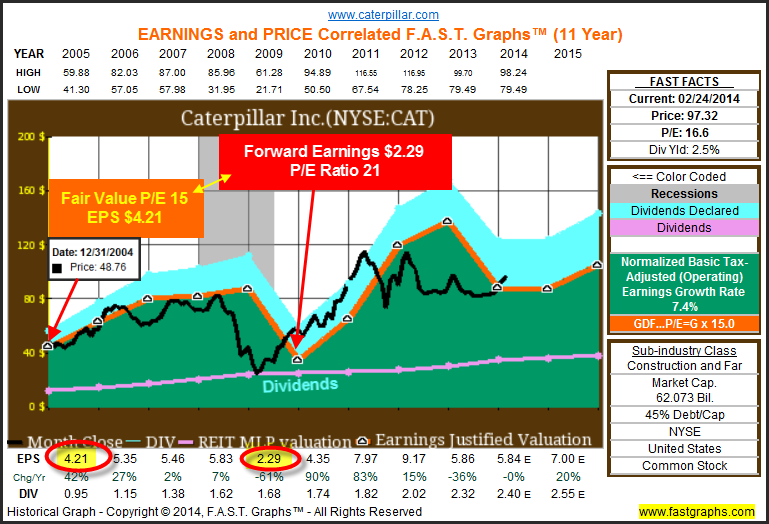
Moreover, from a long-term total performance perspective, Caterpillar Inc. would have provided index beating returns in spite of the cyclical nature of its operating results. Both capital appreciation and total cumulative dividend income have exceeded the S&P 500 from the beginning of 2005 to current time. In other words, an investment in Caterpillar Inc. did work out over the longer-term, but it’s the cyclical periods of time in between that presents the challenges.
If the total return investor were to be patient, or if they were interested in partnering in a wonderful business over trading in and out of the stock, the rewards eventually manifest. At the same time, the dividend growth investor experienced no interruption of their important dividend income payments, and averaged just below 13% per annum average growth of their dividend income. Consequently, for those living off of their dividends, they received a nice average increase in pay. Admittedly, their pay raise was lower during the Great Recession, but increased nevertheless.
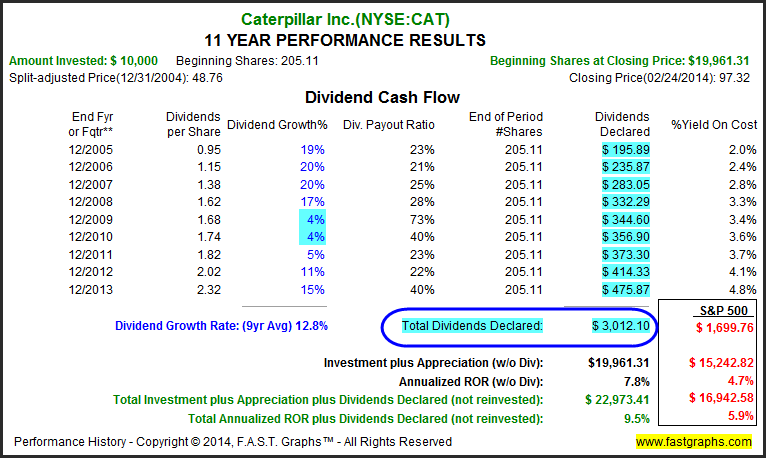
I offer Deere & Company as a second example of a blue-chip dividend paying cyclical stock with similar characteristics and performance that we saw with Caterpillar Inc. I will let the graph speak for itself, and only offer the second example to illustrate that other cyclical blue chips share the traits discussed above as we saw with Caterpillar.
Deere & Company: (DE)
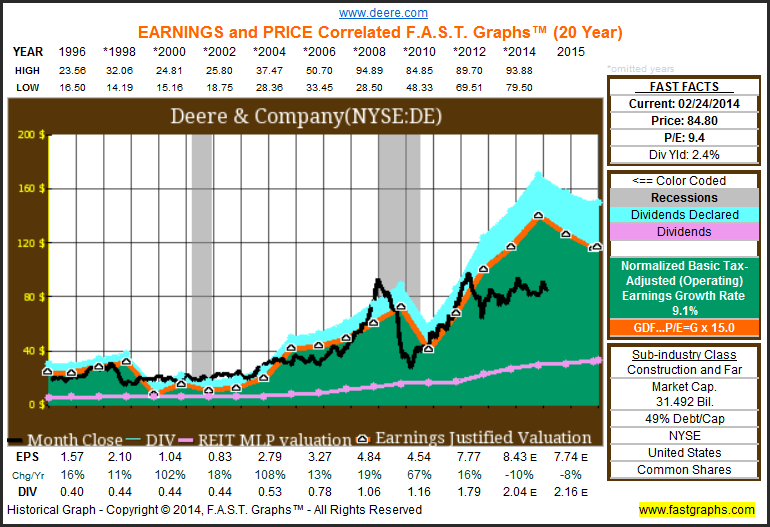
ConAgra Foods, Inc (CAG)
ConAgra Foods, Inc. operates as a packaged food company in North America. The company has a commercial foods presence, supplying frozen potato and sweet potato products, as well as other vegetable, spice, bakery, and grain products to various restaurants, foodservice operators, and commercial customers. ConAgra Foods, Inc. was founded in 1919.
With my next example to illustrate the challenges of investing in cyclical stocks, I offer ConAgra Foods, Inc. I present this example to illustrate that there is a real danger, even to the dividend growth oriented investor, of investing in cyclical stocks. By focusing on the pink line which plots dividends on the ConAgra Foods’ graph, we discover that they did find it necessary to temporarily cut their dividends (see red circle on graph). Even though their dividend today is higher than it was before the cut, dividend growth investors that owned ConAgra Foods, Inc. when the dividend was cut would have experienced a cut in pay, albeit only temporarily.

Summary and Conclusions
Hopefully this article illustrates why I have always personally preferred investing in companies with consistent long-term records of operating excellence. So much so, that I have a tendency to prefer a consistent record of earnings growth over a higher rate of earnings growth. But with that said, and in all fairness, I must add that it is very rare to find a company with a long-term perfect operating record.
Even a quintessential dividend growth stock such as Church & Dwight, will occasionally have a year of flat earnings or even the occasional small drop in earnings from one year to the next. I’ve included a 20-year graph plotting Church & Dwight’s earnings-per-share that are circled at times where earnings flattened or dropped slightly. Minor drops like you see on the following graph do not indicate cyclicality (Note: on a F.A.S.T. Graphs™ exceeding 15 years, only every other year’s data is typed on the graph’s headings, but all data is plotted).
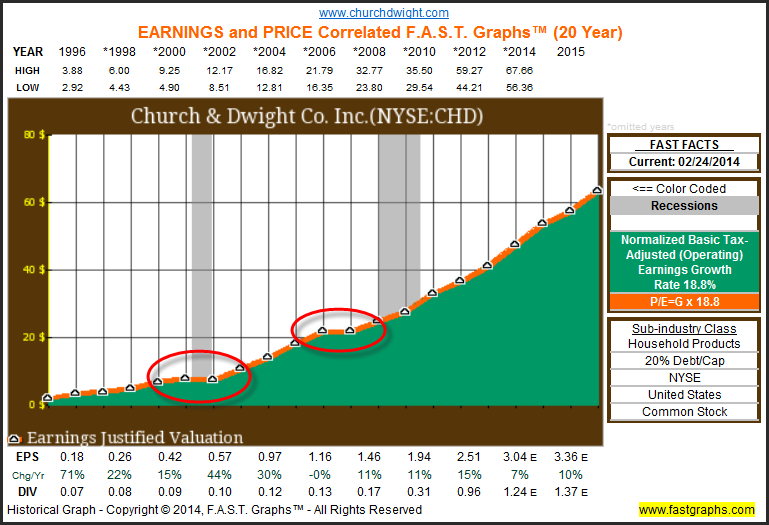
However, there is a difference between occasional minor interruptions in earnings and several years of a cyclical drop of earnings. A minor interruption will usually not have much of an impact on stock price, or it will usually only be short lived if it happens. On the other hand, the company that goes into a two to three-year or longer down cycle is much more troubling and difficult to navigate.
Consequently, the use of cyclical stocks in a retirement portfolio where the investor is focused on income should be limited, at least in my opinion. I’m not saying that the dividend growth investor should never invest in a cyclical company. Instead I’m suggesting that they should only do so sparingly, and with their eyes wide open regarding the true nature of a cyclical stock. In other words, they should be mentally prepared for the potential problems that a down cycle might bring.
As it relates to the total return investor, there are times when investing in a cyclical stock can be very profitable. Of course that means having the courage or fortitude to invest in cyclical stocks when there is the proverbial “blood in the streets.” In other words, the best time to take a position in a cyclical stock is when the cyclical is weak. Then, as the business prospects of the cyclical company improve, earnings growth can be quite substantial, at least for an intermediate period of time.
Therefore, if and when you decide you want to invest in a cyclical stock, regardless of your investment objective, caveat emptor (buyer beware). Knowledge is power.
Disclosure: Long CAT, DE, IR at the time of writing.
Disclaimer: The opinions in this document are for informational and educational purposes only and should not be construed as a recommendation to buy or sell the stocks mentioned or to solicit transactions or clients. Past performance of the companies discussed may not continue and the companies may not achieve the earnings growth as predicted. The information in this document is believed to be accurate, but under no circumstances should a person act upon the information contained within. We do not recommend that anyone act upon any investment information without first consulting an investment advisor as to the suitability of such investments for his specific situation.
